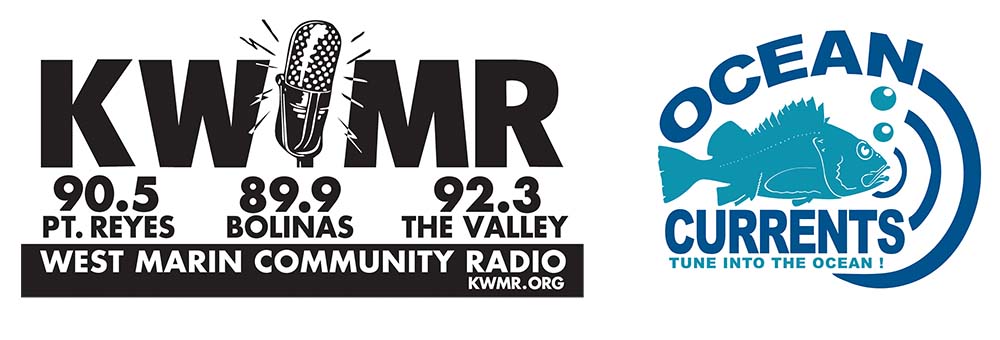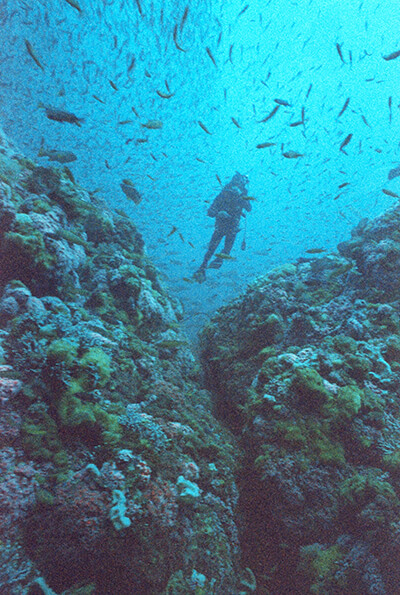Ocean Currents Top 10 Podcasts Reveal Some of the Ocean’s Best Kept Secrets!
Written by Nola Schoder, sanctuary volunteer

Ocean Currents, a radio program broadcast out of KWMR, Community Radio for West Marin, has been riding the airwaves for 14 years! Over 100 shows, available on the Cordell Bank National Marine Sanctuary website and as a podcast, feature experts on ocean conservation, science, exploration, natural history, issues, and expeditions, all offering listeners the opportunity to dive into the wonders and mysteries of our blue planet, the ocean.
Brought to you from Cordell Bank National Marine Sanctuary, off the coast of Northern California, host Jennifer Stock, Education and Outreach Coordinator, adds enthusiastic, fun, and witty charm to the salty tales and new studies that bring to life a remote and diverse ecosystem.
Have you ever wondered what happens when whales die? What are those funky large fish that look like a flying saucer? Why and how do some ocean animals glow in the dark?
In addition to these topics, Ocean Currents takes us on a journey through the discovery of Cordell Bank and other far off ocean places and highlights many of the charismatic megafauna and diverse species that inhabit the California Current Ecosystem, from the crucial tiny krill to the now thriving elephant seal population, and then to the largest mammals, the humpback and blue whales. Of course, there would be no ocean life without reproduction and the weird and wild ways that animals find partners in the sea.
With more than 80% of our ocean unmapped and unexplored, Ocean Currents is at the forefront of the discussion on exploration, research, and innovations of the marine ecosystem. Hear about new species being discovered, advances in science and ocean health, and sustainable uses of the ocean.
Ocean Currents illustrate how we are all intertwined and how human-induced threats like plastics and climate change have an intrinsic effect on the ocean and animals, and introduces those who are making a difference. There is no end to the magnificence of the ocean and why it is so vital to our life.
Ready to start listening? Here’s our Top Ten Ocean Currents shows to help you dive in and start learning!
1. Cordell Expeditions: The early explorations of Cordell Bank

Cordell Bank is an offshore, underwater rocky reef that was unexplored until an intrepid group of Bay Area divers decided to explore it in 1977! Imagine being the first to explore an area 120 feet below the sea, then to be welcomed by an incredibly lush, colorful garden of plants and animals. Hear from Bob Schmieder, the leader of this decade of exploration who was an instrumental advocate to the area becoming the national marine sanctuary that it is today.
2. Broadcast live from the E/V Nautilus: Ocean Currents reporting from afar!
Reporting live (live at the time!) to listeners from the exploration vessel Nautilus, an ocean exploration ship, Ocean Currents speaks with scientists as they share their most recent discoveries. Hear about how they explore and what incredible discoveries scientists in the sanctuaries are making. There is still so much to learn about the deep sea!
3. Seaweed Harvesting
Put down that sushi roll and let’s talk about seaweed! That slimy plant-like algae that washes up on the beach offers nutritional and herbal values and so much more. Learn about some of the species on the California coast, its beneficial properties, plus tips for you to harvest your own sustainably!
4. 3-D Ocean Farming - A Restorative Model
A garden in the sea? Our ocean offers an incredible opportunity to grow and cultivate a bounty of crops. Learn how a 3D sustainable model of farming helps restore ecosystems and puts food on the table all while reducing our carbon footprint. Sounds like a win-win-win.
5. Elephant Seals at Point Reyes National Seashore

Have you ever heard the incredible cacophony from an elephant seal colony? In this episode you’ll hear some surprising sounds and learn about some amazing adaptations and hardships elephant seals overcame to return from near extinction in California waters.
6. Krill: A Keystone Species in the Ocean
Krill are one of the biggest energy sources in the food web. How is this tiny critter so significant for fish, seabirds, megafauna, marine mammals, and humans? Without it, the ocean would be a very different place! So much is packed into this show from krill’s central role in the ecosystem, how they reproduce, how climate change may impact krill, and some innovative technology for studying krill.
7. What happens to a whale when it dies and ends up on the seafloor?

Decomposition has never sounded so wonderful. An amazing and interesting ecosystem forms around a whale fall from the first scavengers of sharks and birds down to red glowing, bone-eating worms. This is an interesting ecological story of how nature recycles itself.
8. Everything you wanted to know about the ocean sunfish (Mola mola)
A big swimming head with little fins that increases in weight 60 million times from its egg size to its full adult form? That’s like a human baby growing up to weigh as much as six Titanics! Find out more unique traits of the odd-looking ocean sunfish that holds two Guinness World Records.
9. Who Glows There?
Marine folklore tells the story of ships sailing through the night over an illuminating sea. And while mysterious, it is an actual phenomenon. Many ocean critters have the magical ability to glow in the dark, and it occurs with some organisms on land, too. Learn how and why they have evolved to perform this clever trick.
10. Do plastics in the ocean smell like food to ocean seabirds?
Why are animals confusing plastic for food? Hint: Marine seabirds use their sense of smell to find food, and the smells emitted by plastics in the sea may smell like a scrumptious meal. 80% of the plastic in the ocean comes from land and is wreaking havoc on marine ecosystems and food webs. You’ll also hear about the global impact as plastics in one area can show up in another part of the world. Special Bonus: This is the 100th episode of Ocean Currents!
11. Sex in the Sea - Strategies from the Sea!
Okay we had to throw in an 11th episode, because who doesn’t want to learn about ocean reproduction?!
Ocean creatures have weird behaviors related to mating. Learn about a few of these unique rituals like a “copepod singles bar,” lobsters’ urine love potion, and the whale’s long-distance serenading. Life would not exist without some diverse copulation or reproduction strategies. Guest Marah J. Hardt tells her science stories that are sure to pique your imagination.
Psst! If your curiosity is heightened, there is a second interview with worms, octopus, and sharks, oh my!
These are our Top 10 shows, but we could not resist sneaking in an extra one. With over 100 episodes archived on the podcast, there are many many more that you can dive into to keep up on ocean information. Subscribe to the Ocean Currents podcast here.

